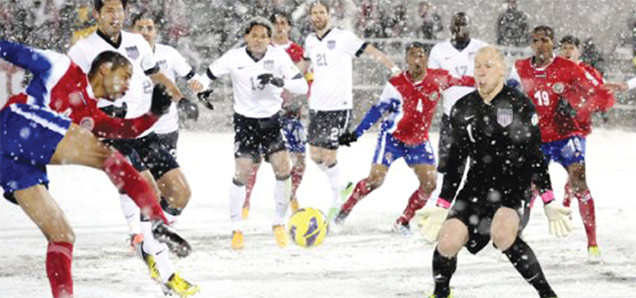Fanshawe FC: Can MLS weather the winter weather?
 CREDIT: REUTERS
CREDIT: REUTERSFebruary�s World Cup Qualifier between the U.S. and Costa Rica. This scene could be more common should MLS change their schedule.
Could North American soccer be, at least partially, played during the winter? That's what Major League Soccer is continuing to ask as they move closer to a winter schedule. The game on this side of the pond has embraced many of the European ideas of how football should be run and supported. A winter schedule would be another one of these ideas. But is it possible.
Let's look at the limitations. The rumoured changes to the schedule would mean the season would start in July or August (depending on international competitions, likely), take a four- to six-week break in the dead of winter, and then finish the season in May or June. It doesn't take a smart person to realize playing soccer in Toronto in February is a terrible idea, so I won't dwell on that. What I will argue against is the length of the break.
In Europe, two- or three-week breaks are common, to avoid games being snowed out during the colder parts of winter. Sure, Europe's winters aren't as harsh as North America's, but more importantly, they are much shorter. In Europe, the temperature tends to rise come February, with snow very rarely falling in March.
In North America (specifically Canada and northern U.S. states), snow is common to fall anywhere from December to March — that's a bit longer than four- to six-weeks. If MLS thinks taking a European style six-week break will prevent snowy games, they are very wrong.
Also, why stop playing in the summer? The North American Soccer League, the league below MLS, has implemented a “split-season” schedule — playing in the spring, taking a couple weeks off in the summer, then have another half in the fall (the winners of each “season” play each other in a final at the end of the year).
What good does that do? If the league isn't playing during some of the nicest weather of the year, what about fans? Would casual Montreal Impact fans come to a match in July, or in February? You're losing money not playing during the summer.
Finally, think about where your players are coming from. There is no outdoor, competitive soccer being played in North America during the winter, so why would your top league suddenly change? It will throw the system out of whack, with developmental leagues working at different times than the main league.
Besides, these smaller leagues and teams can't switch over to a winter schedule either, because they can't afford things like undersoil heating and whatnot.
Overall, switching the calendar for whatever reason does more harm than good to the game in North America. There will be fewer fans, more games cancelled due to the weather and lower quality on the field because players will not be used to playing in those conditions. Why change, and why change now?













